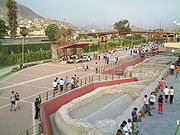
Lima City Walls
Encyclopedia

Melchor de Navarra y Rocafull
Don Melchor de Navarra y Rocafull, jure uxoris Duke of Palata, Prince of Massalubrense was a Spanish politician. From November 20, 1681 to August 15, 1689 he was Viceroy of Perú.-Early career:Navarra y Rocafull studied in the Universities of Oviedo and Salamanca...
between 1684 and 1687 to protect Lima
Lima
Lima is the capital and the largest city of Peru. It is located in the valleys of the Chillón, Rímac and Lurín rivers, in the central part of the country, on a desert coast overlooking the Pacific Ocean. Together with the seaport of Callao, it forms a contiguous urban area known as the Lima...
against attacks from pirates
Piracy
Piracy is an act of robbery or criminal violence at sea. The term can include acts committed on land, in the air, or in other major bodies of water or on a shore. It does not normally include crimes committed against persons traveling on the same vessel as the perpetrator...
and privateer
Privateer
A privateer is a private person or ship authorized by a government by letters of marque to attack foreign shipping during wartime. Privateering was a way of mobilizing armed ships and sailors without having to spend public money or commit naval officers...
s. They included 34 bulwarks and five gates; their total cost was estimated at 400,000 Spanish dollars. The walls were torn down in 1872 under the presidency of José Balta
José Balta
José Balta y Montero was a Peruvian soldier and politician who was president of Peru from 1868 to 1872. He was the son of John Balta Bru and Agustina Montero Casafranca....
as part of the expansion process of the city.
Some sections of the walls of Lima can still be seen today. Part of the wall has been restored at the back of the Church of San Francisco, near the Government Palace; this area now constitutes the public Parque de la Muralla (Park of the Wall). In this park it is possible to observe remains of the wall's foundations. In the 1980s, a developer was beginning excavations at the site near the Rimac River
Rímac River
The Rímac River is located in western Peru and is the most important source of potable water for the Lima and Callao Metropolitan Area.The river is part of the Pacific watershed and has a length of 160 km...
and these walls were discovered and later converted into the park.

